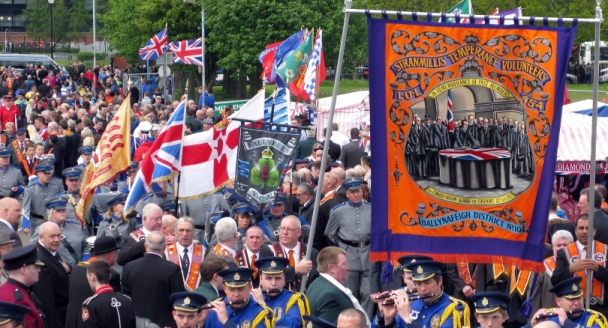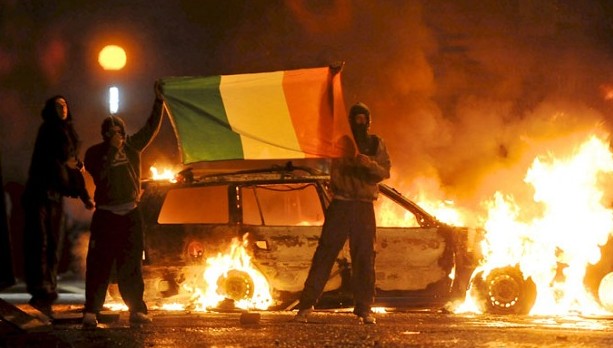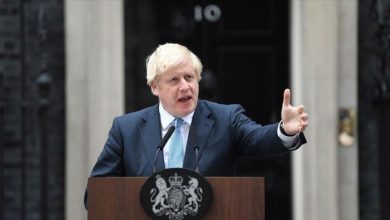Before the daylong marches, riot police clashed with Irish nationalist men and teens on the edge of Catholic west Belfast. They arrested 10 suspected rioters and said three of their officers suffered minor injuries from hurled stones, bricks and bottles.
That trouble flared as Protestants gathered around hundreds of midnight bonfires that precede the Orange Order parades on the Twelfth , an official holiday in this British territory of 1.7 million. Bonfire revelers sang anti-Catholic songs and cheered as Irish flags were tossed into the flames.
The Twelfth officially commemorates King William of Orange’s military victory on July 12, 1690, versus forces loyal to the deposed Catholic king of England, James II. Protestants consider that victory a key moment when Protestant rights in Ireland were secured. Many of the hand-painted banners carried by Orangemen depict William, sword held aloft triumphant on a white horse, alongside the central Orange symbol of a British crown atop an open Bible.
The July marches of Orangemen in suits, bowler hats and medallion-bedecked Orange vestments have stoked conflict with the Irish Catholic minority since the early 19th century. Their sectarian intent is brashly underscored by accompanying military-style ensembles of fife and drum called “kick the pope” bands.
Police are particularly braced for trouble Thursday night when Orangemen pass Ardoyne, an Irish nationalist district in north Belfast that has spawned riots for the past three years of marches.
In the morning, about 200 Catholic protesters lined the disputed road beside Ardoyne as a similar number of Orangemen marched past under heavy police protection. The locals unfurled banners on both sides of the road, one saying “Residents rights are being trampled on,” and the two sides exchanged verbal taunts. A few dozen Irish nationalist men jostled with police after the Orangemen had passed, but no injuries were reported.
Both sides warned of much greater dangers of violence when the Orangemen return in the evening. Last year, 16 policemen were wounded during two nights of Ardoyne street clashes involving several hundred men and boys bombarding police lines with Molotov cocktails, wood planks and even stolen furniture. Rioting in the area was worse in 2010 and 2005.
This year a British government-appointed Parades Commission has tried to reduce the confrontation by ordering the area’s Orangemen to pass Ardoyne three hours earlier than usual. The commission also authorized an anti-Orange parade by Ardoyne residents 90 minutes later.
Protestant leaders initially decried the deadline as impossible, given that their often elderly marchers would need to cover six miles (10 kilometers) on foot in less than an hour. But they decided Thursday that Orangemen planning to parade past Ardoyne would arrive in the area by bus, rather than foot, to meet the deadline.
That decision appeared to eliminate fears of a lengthy standoff between Orangemen and police, but worries persisted that the Ardoyne residents’ own later demonstration would trigger clashes.
Gerry Adams, leader of the Irish nationalist Sinn Fein party, appealed to both sides to avoid street fights with the police, who typically flood the area in their hundreds to ensure that the two sides cannot get within striking distance of the other.
Adams said the crux of the problem was the Orangemen’s decades-old refusal to negotiate directly with anti-Orange groups from Catholic districts.
“The Orange (Order) should have their day, but the people in the host community have a right to be talked to,” Adams said.
The day’s mass demonstrations traditionally provoked fear and loathing among Catholics, demonstrating Orange power in what was once a Northern Ireland governed and policed overwhelmingly by its British Protestant majority.
Those days of dominance are gone. Britain abolished the Protestant local government in 1972 during the worst year of bloodshed, and in 1998 formed the Parades Commission to impose police-enforced restrictions on Orange marches near Catholic areas. After initial violent resistance, Orangemen have grudgingly accepted most restrictions but still refuse to talk to the anti-Orange groups.
Commentators agree that the Orangemen’s boycott on direct contact with the enemy appears anachronistic given that Northern Ireland since 2007 has had a unity government jointly led by Orangemen and Sinn Fein.
But the Ardoyne conflict also defies easy resolution because of the tight confines of Belfast geography. The Orangemen want to walk back to their lodge, and Ardoyne lies the side of the main road connecting that lodge to downtown Belfast. The parade mostly passes Ardoyne’s street-facing row of small shops, not homes, so it’s inaccurate to say the parade travels through a Catholic area.
[adrotate banner=”31″]




